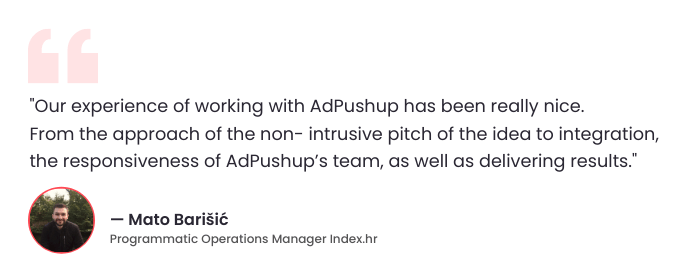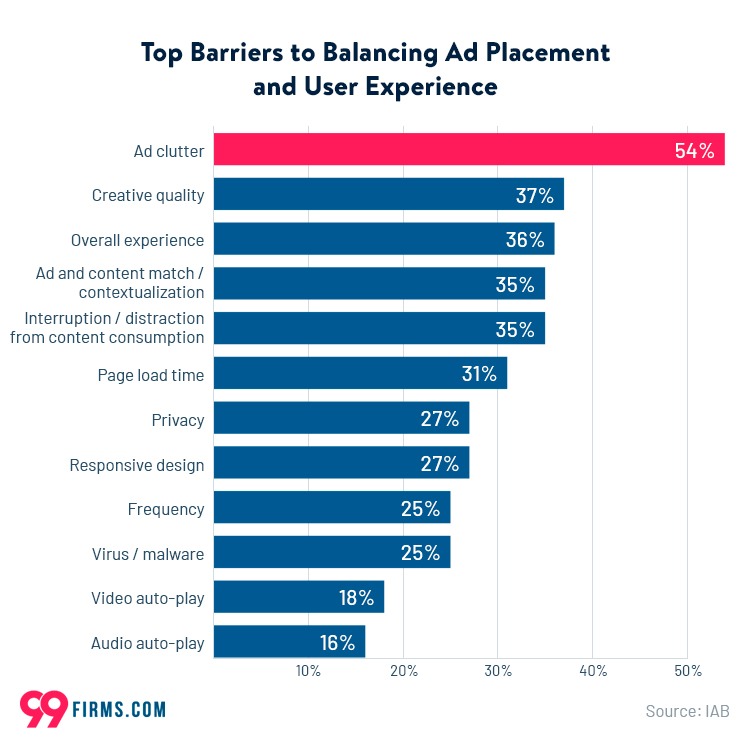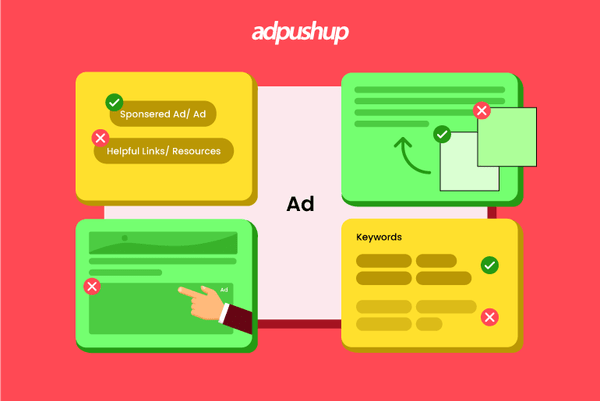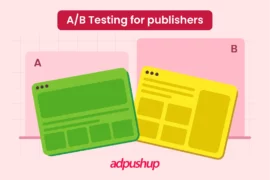If you’re looking for some key tips to improve ad performance, check out these pointers and strategies.
If you are an ad publisher, you have to keep your audience engaged enough. You need to find the perfect balance between regular content and ad content, otherwise known as ad density, to maintain a great user experience.
With this situation shadowing the entire industry, publishers need to follow specific steps and take certain precautions to ensure that their business and income are not jeopardized due to the decreased ad appetite of the audience. In this article, we aim to cover a few points that might help ad publishers boost their ad performance in the long run.
What is Ad Performance?
Ad performance is a reflection of how well an advertising campaign resonates with its audience, determined by their response and engagement. Since the revenue of many publishers depends on the ads, they should make sure they are performing effectively on their websites.
Let’s understand the same thoroughly.
Why Do Ad Performance Matter to Publishers?
Ad performance holds significant importance for publishers due to its far-reaching implications:
Revenue Generation
Publishers rely on advertising as a primary revenue source. Monitoring ad performance is crucial to ensure a steady income stream. When ads perform well, they generate higher click-through rates (CTR) and better conversion rates, directly influencing a publisher’s financial health.

Enhanced User Experience
Second, publishers aim to deliver valuable content to their readers. Well-performing ads are typically more relevant and engaging, contributing to an overall improved user experience. Satisfied visitors are more likely to return, increasing traffic and ad impressions.
Effective Ad Space Utilization
Publishers have limited ad space on their platforms. Effective ad performance allows them to maximize this valuable real estate by displaying ads that resonate with their audience. This optimization ensures that every impression counts and contributes to revenue.
What are the Metrics to Measure the Ad Performance
There are multiple metrics that publishers employ to measure the effectiveness of their ads. Let’s have a look at some of them.
Average Click-Through Rate (CTR)
Click through rate reveals the percentage of viewers who not only saw your ad but also engaged with it by clicking. This metric serves as a litmus test for the effectiveness of your ad’s copy, design, and landing pages. A higher CTR signals resonance with your target audience.
Conversion Rates
Conversion rates are the pulse of any business, quantifying sales growth and audience engagement. It measures the proportion of visitors who take a specific action, such as filling out a form or making a purchase. Robust conversion rates signify the efficacy of your campaigns.
Cost per Mille (CPM) or Cost per Thousand Impressions
Cost per mile reflects the expenditure associated with acquiring 1000 ad impressions on a single webpage. Understanding how publishers define an impression is crucial, as it can affect your CPM. Impressions tally ad views rather than clicks or sales. Typically, a favorable CPM falls in the range of $1.00 to $3.00.
Cost per Click (CPC)
CPC, an integral component of Pay-per-click (PPC) advertising, represents the price paid by advertisers when users click on their ads, regardless of the resulting purchases. CPC fluctuates based on chosen keywords, search volume, and ad type, varying between platforms like Google AdWords (potentially reaching $20.00) and Facebook (as low as $2.00).
Cost for Acquisition or Action (CPA)
CPA campaigns charge advertisers for specific actions—be it clicks, form submissions, or sales—rather than mere clicks. This model minimizes financial risks for advertisers, as payments are tied to desired outcomes.
Revenue
Revenue serves as the North Star for businesses, reflecting the success of sales and marketing strategies. Meeting revenue goals hinges on the effectiveness of these strategies and the ability to attract and retain customers profitably.
Return on Marketing Investment (ROI) or Return on Ad Spend (ROAS)
ROI and ROAS act as vital yardsticks for evaluating the impact of marketing expenditures on overall revenue. These metrics shed light on campaign efficacy and substantiate marketing performance.
Total Customer Acquisition
Determining the number of customers required establishes clear benchmarks for marketing and sales teams, facilitating budget allocation and the pursuit of shared objectives. This alignment fosters sustainable business growth and prosperity.
By vigilantly tracking and analyzing these metrics, you empower your team with clarity of purpose and direction, uniting them in pursuit of your company’s vision and objectives.
Now let’s understand certain ad performance challenges that publishers experience.
Ad Performance Challenges Publishers Face
To know more about this, we need to refer to the effects of the pandemic – the COVID situation that had the entire world reeling under its grasp. It created a considerable hike in organic traffic as people shut inside their homes turned to the internet for all kinds of information and connection. As a result, the demand for content automatically increased, which was quite understandable.
However, this is only sometimes good news for publishers. Although the demand for content increased, publishers dependent on ad revenue started seeing a decline in their ROI. The reason was that the advertisers gradually pulled back on the ad expenditure.
The industry experienced similar turbulence with the start of the war in Ukraine and subsequent economic and political implications.
The publishers now need to formulate new strategies at par with the requirements of this new normal.
On the other hand, since consumers are now eager for quality content only, it has brought about some more challenges for ad publishers.
- Traditional ad placement is now old news, and this has also decreased ad revenues to a great extent. So if you want to maintain a CPM or Cost Per Mille, which is satisfactory, you have to do away with unprofitable ad spaces. But this is only a temporary solution and might be problematic in the long run.
- Another major problem is publishers need to get proper access to the details of audience insights. With the introduction of the new privacy laws and the phaseout of third-party cookies, they no longer have the option of relying on data procured from intermediaries and third parties.
- Some publishers have shifted to a strategy of building a repository of first-party data. This is done by collecting information through purchase history, registrations, sign-ups, and other pieces of data. But the challenge is there are only 10% of publishers on the web use first-party data about their audiences. 90% of publishers have still been using third-party data and cookies to collect data about their audiences. But now that those cookies are becoming obsolete, this can be seen as a challenge.
Also Check: Ad Layout Optimization and Ad Layout Personalization
How Publishers Can Cope Up With Changing Trends
Customers are now primarily ad-weary, and publishers need to come up with new strategies to improve ad performance that are creative and efficient in the long run. But to successfully create this new strategy, it is imperative to understand why the traditional methods failed. Here are the main reasons why the conventional form of advertising failed:
Accept the Changing Behaviour of Customers
Decide on a Niche for your Ads
No matter what business you’re in, publishers can research and find the right niche while placing their ads to remain relevant and formulate them in a way that customers will also find interesting. There will always be several niches within your audience. For example, some of your audience may only use their smartwatch for tracking footsteps, others may use it to track their sleep patterns and heart rate, send messages, answer calls, and other sensor-related features.
So, not all of your target audience uses all of this data which means different people will be interested in the different smartwatch brands.
With niche audience targeting, you can reach people based on how they have interacted with your site before, their habits and interests, likes, dislikes, and even their life events. You can also decide according to users’ behaviors to anticipate what ad they should be shown. With niche targeting, you can not only optimize your ad campaign but can also increase the quality of your traffic.
Read More: Optimising Adsense Revenue and Picking the Right Niche
Shift Your Focus to Best-Performing Content
As mentioned before, this is the time when the percentage of organic traffic has already increased. Publishers should use this to their advantage and build their organic audience by creating SEO-optimised and meaningful content with videos. These will last longer and be valuable to their ad repository. Another good idea is to take your best-performing content and repurpose it into other content types, such as videos or podcasts.
A well-thought-out strategy, experimenting with new ad formats and varying lengths of ads, will give insights on how to drive traffic back to your website.
How to Improve the Ad Performance of Your Neglected Poor Ads?
Ad management and struggles regarding content are something that disrupts the functioning of a lot of publishing companies. But some essential practices may turn out to be the answers to the problem and save your neglected and poor ads from falling behind the mark.
1. Avoiding Accidental Clicks
Vert first thing you should do to increase your ad performance is avoid accidental clicks. Publishers do not have permission to encourage users to click on your ads in any way accidentally. This also includes the implementation of the ads in the content in such a way that they might be mistaken as actual content like a menu, navigation, or download links.

Even if the placement leads to accidental clicks unintentionally, publishers might still get a notice of violation.
Accidental clicks on ads are a serious problem that can take your ad revenue down to 50%. According to CNBC, 50% of the impressions served on ads are from accidental clicks.
The problem of accidental clicks on ads is quite common, especially on ads that are served on mobile devices and where users often hit ads through endless scrolling on social media channels or news feeds.
This problem can quickly eat up your budget. There are three main strategies for handling accidental clicks. The first one is to view your website in desktop mode and mobile mode.
Check if something is wrong with your ads. Refresh and load the site again to check if anything is causing any unintentional clicks. Also, remove the unnecessary sticky elements that don’t add any value to your website.
Publishers should not draw any kind of unnatural or unnecessary attention to the ads they place. Some examples are videos, animation, arrows, etc., which might draw the attention of the viewers.
2. Avoid Misleading Headers
It is not allowed for publishers to mislead the visitors of their websites in a way that they might not be able to distinguish the content from Display ads.
According to this policy, publishers cannot place ads under misleading headings like “helpful links” or “resources.” Ads may only be labeled as “Sponsored Links” or “Advertisements”.
3. Alignment of the Ads with Images
Publishers are not allowed to associate individual ads appearing on their sites with specific images. This might mislead the users into thinking that the images are directly associated with the advertisements and their individual offerings, which is not correct.

Images, videos, and visuals are proven to increase user engagement on your ads, meaning visitors stay on your ads longer and pay more attention to what you have to offer. According to research, we found that ads with interactive visuals receive 116% more organic traffic than those that don’t. We have also discovered that video ads garner 83% more traffic and attract 55% more responses.
Also Read: Where To Place Your Ads? 5 Best Ad Placement Strategies (2023)
4. Be Careful with your Content Strategy
This is basically about the content strategies you have for your ad campaigns. Select the right keywords in your ads that you want to target your audience, eliminate all the unnecessary words or unnecessary keywords, and publish ads that are well-oriented and attract consumers to visit your website.
This can be done with a well-thought-out content strategy. With reference to the ads, publishers should not miss any optimization. This will increase the ad effectiveness to the maximum, and your ad campaign will also be more efficient.
We also cannot overlook the importance of ad attractiveness; you should always stimulate ad creativity to make ads more and more attractive for each new campaign. By attractive, it doesn’t just mean an ideal design. But it’s more about using better resources such as quality content, visuals, and videos. Try to innovate your ad content to grab the attention of your audience.
Offering compensation or incentives for clicks on ads is prohibited. This is not an exhaustive list, and there are many other policies that need to be followed when it comes to ad placement.
Final Words
In a nutshell, the publishers should focus on achieving the end goals. Once you are sure that you have placed your ad properly with content that does not disrupt the viewers, 50% of your problems are solved.
For the rest of it, if you can follow the tips and tricks provided in this article, you can surely recover the loss in revenue that you have incurred from blocked ads and neglected poor ads over all this time.
We have helped hundreds of publishers globally to set up high-performance ad layouts and increase ad revenue. You can also start personalizing the ad layout for each visitor. Get Started here.
Frequently Asked Questions
For ads optimization follow these tips:
a) Perfect your content structure
b) Optimize for your brand objective and business niche.
c) Work on ad alignment and images.
d) Target the right audiences.
e) Avoid accidental clicks on your ads
f) Avoid misleading headers
There are a few metrics that publishers can use to measure ad performance:
a) ROI and conversion from ads
b) Average click-through rate (CTR) on ads
c) By measuring Cost per mille (CPM), Cost per Click (CPC), Cost for acquisition (CPA)
CPM (Cost Per 1000 Impressions) is the best way to measure the cost-effectiveness of an ad and ad campaign. Using this metric publishers can analyze the costs for different campaigns.

Deepak has a keen eye for detail and a deep understanding of the ad tech landscape. Whether it’s through in-depth articles, thought-provoking insights, or compelling storytelling, he’s dedicated to helping people navigate the complex world of ad tech with the simplicity of his words.





